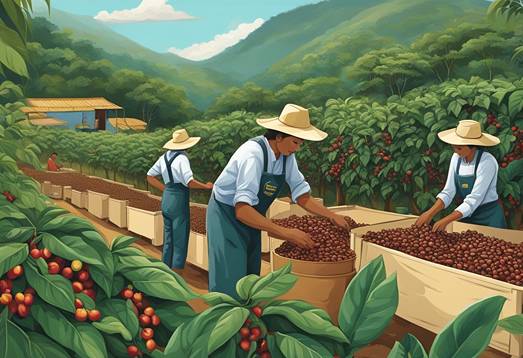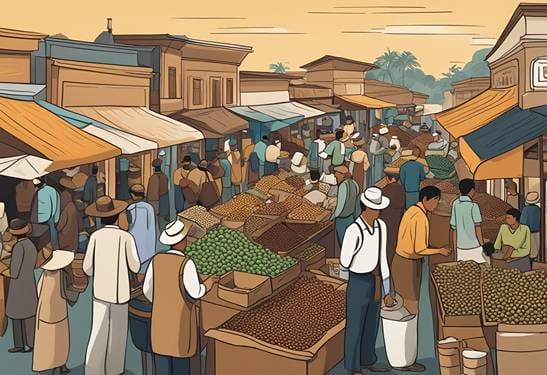As a coffee lover, you might have come across the terms “Arabica” and “Colombian coffee” and wondered what distinguishes them.
To clear up any confusion, let’s dive into the comparison between these two types of coffee.
Arabica coffee is one of the most popular and widely consumed types of coffee around the world. It comes from the plant Coffea Arabica, native to Ethiopia.
On the other hand, Colombian coffee refers specifically to Arabica beans grown and harvested in the country of Colombia, located in South America.

The unique climate, soil, and coffee cultivation methods in Colombia contribute to the distinct characteristics of Colombian coffee.
It is important to understand that Colombian coffee is essentially a subtype of Arabica coffee.
However, there are noticeable differences in flavor profiles, aromas, and even caffeine content between them.
This is due to the varying cultivation and processing practices used in each region.
Key Takeaways
- Colombian coffee is a subtype of Arabica coffee, grown in Colombia.
- Differences between Arabica and Colombian coffee are influenced by their unique cultivation and processing methods.
- Flavor profiles, aromas, and caffeine content vary between Arabica and Colombian coffee.
Arabica vs Colombian Coffee – Origins and Types

Historical Background of Coffee
The history of coffee can be traced back to Ethiopia, where it was discovered in the 9th century by a shepherd who noticed the increased energy levels in his goats after they had eaten coffee berries.
From there, the popularity of coffee spread to Arabia and eventually to other parts of the world.
Early Arab traders began cultivating the Coffea Arabica plant, which produced the first coffee beans known as Arabica coffee.

Types of Coffee Beans
There are primarily two types of coffee beans in the world:
- Arabica Coffee: This type of coffee bean comes from the Coffea Arabica plant, which originated in Ethiopia. They are considered to be higher quality beans and account for about 60% of the world’s coffee production.
- Robusta Beans: These beans come from the Coffea canephora plant and are known for their strong and bitter taste. They are typically used in lower-quality blends or instant coffee.
Coffea Arabica and Colombian
While Arabica coffee is grown worldwide, Colombian coffee generally is a specific type of Arabica bean grown in Colombia.
The South American country is known for its ideal coffee-growing conditions, which include nutrient-rich soil and optimal climate conditions.
In conclusion, you should know that Colombian coffee is a type of Arabica coffee grown in Colombia, with its distinct qualities and flavor profile.

On the other hand, Arabica coffee is grown worldwide and is the more popular and higher quality option compared to Robusta beans.
Cultivation and Processing

Harvesting Methods
When it comes to cultivating coffee, there’s a significant difference between Arabica and Colombian coffee.
Both are actually grown from the same coffee plant species called Coffee Arabica.
What sets them apart are the specific locations they’re grown in and the methods used in harvesting.
Typically, coffee cherries are picked by hand, ensuring only the ripe ones are selected.
This can result in varying taste profiles, from fruity to earthy notes.
Washing and Drying Processes
The washing and drying processes have a significant impact on the flavor of your coffee.
Arabica coffee is often processed using a natural or dry method, where the cherries are dried in the sun with the outer skin still intact.
On the other hand, Colombian coffee is popular for employing a unique wet-processing method known as “washed Arabica” wet processing method.
Wet processing involves:
- Picking the coffee cherries by hand
- Removing the pulp by mashing the cherries with a pulper
- Allowing the mashed beans to dry in the sun
- Washing the dried beans with water
While the wet-processing method requires more skill and water, it produces a cleaner and brighter flavor profile in the final cup.
Impact of Processing on Flavor
The processing methods play a significant role in the flavor of your coffee. Arabica coffee, since it’s often dry processed, retains more of its fruity flavors and can have varying taste profiles like berries, chocolate, or wine.
Colombian coffee, which is washed processed, has a smoother and brighter flavor, often characterized by hints of citrus and floral notes.
Whether you prefer Arabica or Colombian coffee, rest assured that the care taken in cultivation and processing contributes to the unique flavors and experiences you’ll enjoy with every cup.
Flavor Profiles and Aromas

Understanding Arabica’s Flavor Nuances
When it comes to Arabica coffee, you’ll notice a wide range of flavor profiles. Its taste often features a delightful balance of acidity and sweetness.
Known for its smooth and delicate flavor, Arabica’s low acidity levels give it a pleasant mouthfeel.
You might even pick up hints of fruit, berries, chocolate, or wine, depending on the specific variety and origin of the beans.
Some common Arabica flavor notes include:
- Fruity: apple, blueberry, strawberry
- Floral: jasmine, rose, lavender
- Sweet: caramel, honey, brown sugar
- Chocolaty: milk chocolate, cocoa, dark chocolate
Colombian Coffee Flavor Characteristics
Colombian coffee is also derived from the Arabica species, but it offers a distinct taste and profile compared to other Arabica varieties.
Grown at high altitudes in a tropical climate with plenty of rainfall, Colombian coffee is often described as mild and well-balanced, with a hint of nuttiness.
Some of the standout flavor characteristics of Colombian coffee include:
- Mild Acidity: gentle brightness on the palate
- Medium Body: a pleasant, balanced mouthfeel
- Nutty: hints of almond, walnut, or hazelnut
- Aroma: a rich and inviting scent, often with floral or vanilla notes
Sensory Experience of Coffee Aromas
A major part of enjoying coffee comes down to the aroma experience.
As you sip your morning cup, take a moment to appreciate the bouquet of scents intertwined with the flavors of the beans.
The volatile compounds responsible for coffee’s aroma enhance the overall sensory enjoyment.
When comparing Arabica and Colombian coffee aromas, you may notice the following differences:
- Arabica: A lovely mix of fruity, floral, and sweet scents, complementing its varied flavor profiles.
- Colombian: Often carrying a rich, full aroma with underlying notes of nuts, florals, or vanilla.
By exploring the intricacies of Arabica and Colombian coffee, you can better appreciate the diverse world of coffee flavors and aromas, elevating your daily cup of joe into a truly immersive experience.
Roasting and Brewing

Roasting Techniques for Arabica and Colombian Beans
When it comes to roasting coffee beans, both Arabica and Colombian beans can be roasted using similar techniques.
However, the roasting time and temperature may vary depending on the desired flavor profile.
For instance, lighter roasts tend to highlight the beans’ unique flavors, like floral and fruit, while darker roasts can bring out rich chocolate or nutty notes.
- Arabica beans: Usually roasted at a lighter level to bring out their natural acidity and sweetness.
- Colombian beans: Can be roasted at a wide range of levels, from light to dark, depending on the desired flavor. A medium roast is most common, as it strikes a balance between retaining the beans’ fruity characteristics and developing a deeper body.
Brewing Methods Preferences
For a perfectly brewed coffee, consider the following brewing methods for Arabica and Colombian beans:
- Arabica beans: Since they have a delicate flavor, try methods like pour-over, V60, or Chemex, which will help you appreciate their complex taste and subtlety.
- Colombian beans: Because they offer a well-balanced flavor profile, they work well with various brewing techniques, from espresso to drip, French press, or AeroPress, depending on your preference.
The Impact of Roast on Flavor and Acidity
The roast level of your coffee beans has a significant effect on the flavor and acidity of your brewed coffee.
It’s important to note that:
- Lighter roasts: Preserve the beans’ natural flavors and acidity, giving you coffee with a bright, fruity, and often floral taste.
- Darker roasts: Enhance the body and bitterness of your coffee, producing a more rich flavor with a heavier mouthfeel, but less acidity.
As you experiment with roasting and brewing techniques to maximize the enjoyment of your Arabica and Colombian beans, remember that taste is subjective.
Your perfect cup might be different from someone else’s, and that’s the beauty of coffee exploration!
Health and Caffeine Content

Caffeine Levels in Arabica vs Colombian Coffee
When it comes to caffeine content, there is a small difference between Arabica and Colombian coffee beans.
Arabica coffee beans typically have a higher caffeine content of about 1.5%, while Colombian coffee, which is a type of Arabica coffee grown in Colombia, has slightly lower levels at around 1.3%.
Keep in mind that the caffeine content in your coffee can also depend on factors like roast level, brewing method, and serving size.
Health Benefits and Considerations
Both Arabica and Colombian coffee have various health benefits, mostly due to their caffeine content and antioxidant properties.
Some health benefits shared by both coffee types include:
- Improved mental alertness
- Enhanced physical performance
- Protection against certain diseases like Parkinson’s and Alzheimer’s
Since Colombian coffee has slightly lower caffeine content, it might be a better option for you if you’re sensitive to the effects of caffeine or want to reduce your intake.
However, the difference in caffeine levels between the two coffee types is relatively small, and both provide similar health benefits.
In contrast, Arabica coffee is renowned for its smooth, delicate flavor and low acidity, making it more appealing to some coffee drinkers.
This, accompanied by its higher caffeine content, can contribute to its overall popularity.
Remember that moderation is key when it comes to caffeine consumption.
It’s generally recommended to stay within the daily limit of around 400mg of caffeine for healthy adults.
So, whether you prefer the taste and aroma of Arabica or the unique characteristics of Colombian coffee, enjoy your cup knowing you’re also benefiting from its health properties.
Market Trends and Consumer Preferences

Price Factors and Affordability
When considering Arabica vs Colombian coffee, you will notice differences in pricing.
Arabica beans, known for their smooth and sweeter flavor, are often seen as a premium choice, while Colombian coffee, a type of Arabica known for its rich flavor and consistent quality, can be more affordable for many coffee enthusiasts.
Prices for these coffee varieties are influenced by factors such as production costs, global demand, and market trends.
By understanding these price factors, you can make an informed choice about which coffee best suits your personal preferences and budget.
Popularity and Demand
Coffee is an ever-evolving industry, and consumers’ tastes are constantly shifting.
Arabica coffee makes up around 58% of global production, with Colombian coffee considered one of the popular choices in competitions like the World Barista Championship.
Growing demand for unique and diverse flavor profiles has led to increased popularity of lesser-known Arabica varietals from Colombia.
In recent years, there has been a rise in demand for specialty coffee, single-origin, and region-specific blends.
This trend has made Colombian coffee a popular choice as consumers explore its distinct flavor profiles and cultural significance.
Sustainability and Ethical Sourcing
As awareness about the impacts of global warming and unethical business practices grows, more coffee enthusiasts are prioritizing sustainable and ethically sourced coffee.
Both Arabica and Colombian coffee producers face challenges such as climate change and volatile market conditions.
In light of these factors, many coffee companies are implementing eco-friendly initiatives by focusing on ethical sourcing, fair trade practices, and environmentally sustainable farming methods.
In conclusion, when comparing Arabica and Colombian coffee, consider factors such as price, demanding tastes of consumers, and sourcing practices.
By doing so, you can enjoy your preferred coffee while supporting responsible and sustainable practices in the industry.
| Feature | Arabica Coffee | Colombian Coffee |
|---|---|---|
| Origin | Indigenous to Ethiopia | Indigenous to Colombia |
| Growing Altitude | Typically grown at higher altitudes | Grown at various altitudes |
| Flavor Profile | Smooth, mild, with nuanced flavors | Rich, full-bodied, with mild acidity |
| Acidity Level | Higher acidity, often with fruity notes | Moderate acidity, balanced |
| Growing Regions | Various regions worldwide | Primarily grown in Colombia |
| Bean Appearance | Oval shape, curved sides | Flat-sided with a straight crease |
| Production Volume | Higher production worldwide | Significant production, mainly in Colombia |
| Price | Generally higher due to quality | Moderate pricing due to availability |
| Specialty Use | Often used for specialty coffee blends | Frequently used in blends and as a base |
Conclusion

In the end, the choice between Arabica and Colombian coffee depends on your personal taste preferences. Both offer high-quality beans with distinct flavor profiles to suit different palates.
Arabica coffee beans are known for their milder, more delicate taste, and generally higher acidity.
These beans provide a complex, well-rounded flavor that is often appreciated by coffee connoisseurs. If you enjoy a smoother cup with bright notes, Arabica beans would be a great option for you to explore.
On the other hand, Colombian coffee, which is a type of Arabica bean grown specifically in Colombia, has a rich and smooth taste with a medium acidity level.
This coffee stands out for its distinct flavor profile and is usually more expensive than general Arabica beans. If you prefer a more robust and full-bodied cup with a balanced profile, you might find Colombian coffee more to your liking.
When deciding between the two, consider trying both types and discovering their unique qualities.
You can also experiment with different brewing methods to enhance the flavors.
Keep in mind that it’s always best to buy freshly roasted coffee beans for the best experience, no matter which type you choose.
So, go ahead and enjoy your coffee journey by exploring the delightful world of Arabica and Colombian coffee beans. You might just find a new favorite!
Frequently Asked Questions

What is the general taste profile of arabica coffee, particularly compared to other coffee species?
Arabica coffee beans are known for their sweeter, more complex flavor profile.
Compared to robusta coffee, Arabica beans tend to have a softer, more delicate flavor, with tones of sugar, fruit, and berries.
They also often have a slightly winey flavor, with overtones of nuts and caramel.
The unique flavors of Arabica make it a favorite in the coffee industry and gives you a very distinct coffee experience.
How does the flavor of Colombian coffee differ from others, such as Arabica and Colombian supremo?
The flavor of Colombian coffee is predominantly rich with a mild taste and a hint of nutty undertones when compared to arabica.
Factors such as the altitude where the beans are grown and how the coffee is cultivated play a large role in the flavor development.
Colombian supremo, which comes from some of the highest quality beans, tends to have a more tasteful and aromatic flavor.
A cup of Colombian coffee often has a crisp acidity, medium body, and a pronounced caramel or toffee sweetness.
I’m trying to determine the best coffee for my palate, could you shed light on the differences between arabica and Colombian coffee?
The main difference between arabica and Colombian coffee lies in the variety of the coffee bean and where the coffee is grown.
Colombian coffee is specifically the term used for coffee made from arabica beans grown in the high altitudes of Colombia – part of the coffee belt.
On the other hand, arabica coffee can be grown in various parts of the world, but is typically found in places with higher altitudes that have rich soil conditions.
Hence, your coffee selection should be based on your preference for these varying taste profiles.
How are arabica and colombian coffee beans cultivated and how does this affect the taste?
Both Arabica and Colombian coffee beans are cultivated in similar conditions but in different geographies.
Arabica beans are known to grow coffee in higher altitudes and cooler temperatures, giving them a more refined, sweeter taste.
Colombian coffee, in the climatic conditions of the coffee belt, takes longer to ripen which in turn imparts more sugars and nutrients into the bean, developing a high-quality coffee with a fuller body and well-rounded flavor.
Hence, how and where these beans are grown substantially influences their taste.
How does processing Colombian coffee affect the experience of Colombian coffee?
The process of converting harvested coffee cherries to green coffee beans requires different processing methods, often dictated by region and tradition.
Processing Colombian coffee specifically often involves washing the beans after harvest, which helps to preserve the brightness, acidity, and nuanced flavors of the coffee.
This process attribute gives you a unique coffee experience while savoring a cup of Colombian coffee with its punchy notes and full-bodied feel.
What’s the unique potential of arabica beans in delivering a good cup of coffee?
Arabica beans are considered superior in the coffee industry. They are known for their nuanced flavors and less bitter taste compared to other coffee beans.
A good cup of coffee made from Arabica beans is a complex symphony of flavors, with notes of chocolate, nuts, berries, and even floral undertones. In terms of acidic content,
Arabica beans have a higher acidity, often associated with wine-like taste and is also linked to brightness or tang in coffee.
The resulting potential of Arabica beans in a good cup of coffee is a balanced, room-filling aroma, with less bitter and smoother taste than its counterparts.
Can you describe the experience of brewing arabica and Colombian coffee blends?
Brewing Arabica and Colombian coffee blends promises a flavorful cup of coffee.
The unique characters of both complement each other well and offer a balanced and satisfying cup.
Arabica’s slight sweetness and soft flavor lend a nice base, while the Colombian coffee’s rich and robust flavor characteristics provide a more full-bodied experience.
Together, they create flavored coffee blends with a depth of taste, nuanced flavors and a sensation that is ultimately pleasing to many coffee lovers.

